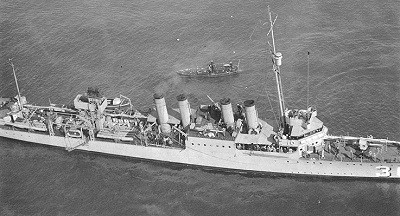Farragut II (Destroyer No. 300)
1920-1930
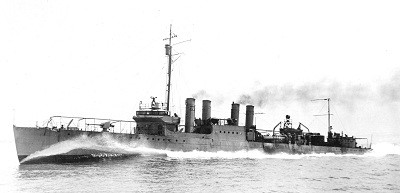
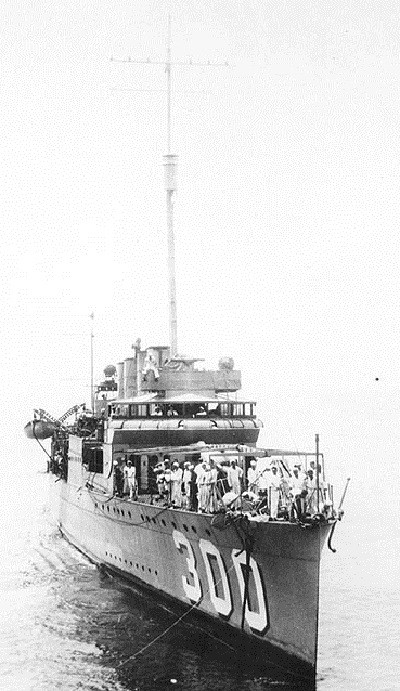
The second U.S. Navy ship named to honor David Glasgow Farragut (5 July 1801-14 August 1870). See David Glasgow Farragut for additional information. The first Farragut (Torpedo Boat No. 11), was renamed Coast Torpedo Boat No. 5 on 1 August 1918, and served, with some interruptions, from 1899-1919. The third Farragut (DD-348) was renamed Smith on 15 July 1933, renamed Farragut on 12 August 1933, and served from 1934-1947. The fourth Farragut, a guided missile frigate (DLG-6), was projected as DL-6 but reclassified on 14 November 1956, reclassified as a guided missile destroyer (DDG-37) on 30 June 1975, and served from 1960-1992. The fifth Farragut (DDG-99) was commissioned on 10 June 2006.
II
(Destroyer No. 300: displacement 1,190; length 314'4"; beam 31'8"; draft 9'4"; speed 35 knots; complement 95; armament 4 4-inch, 12 21-inch torpedo tubes; class Clemson)
The second Farragut (Destroyer No. 300) was laid down on 4 July 1918, Independence Day, at San Francisco, Calif., by the Bethlehem Shipbuilding Corp.; launched on 21 November 1918; sponsored by the wife of Capt. Templin M. Potts, USN (Ret.), President of the Board of Inspection and Survey, Pacific; and commissioned on 4 June 1920, Cmdr. Pierre L. Wilson in command.
Farragut sailed from the Mare Island Navy Yard, Vallejo, Calif., on 2 July 1920, and the following day reached San Diego. Soon thereafter, as the Navy adopted a standard system of ship nomenclature, the ship was redesignated as DD-300 on 17 July 1920. The ship served initially with Destroyer Division (DesDiv) 32, Destroyer Flotilla 5, Destroyer Squadron (DesRon) 4, Pacific Fleet. She completed repairs at the Puget Sound Navy Yard, Bremerton, Wash., and on 31 March 1922 resumed full commission. Farragut participated in the Portland (Ore.) Rose Festival (18–29 June), and returned to San Francisco on 6 July. The destroyer took up a regular training schedule along the west coast, carrying out division gunnery and fleet tactical exercises in California waters into 1923.
The annual fleet problems concentrated the Navy’s power to conduct maneuvers on the largest scale and under the most realistic conditions attainable. Fleet Problem I included a test of the defenses of the Panama Canal against aerial attacks. The Blue Fleet and Army coast artillery and aircraft defended the important isthmian waterway, assisted by 18 patrol planes of Scouting Plane Squadron 1 operating from tenders Wright (AZ-1), Sandpiper (AM-51), and Teal (AM-23). Planners compensated for the lack of aircraft carriers and planes for the attacking Black Fleet by designating two battleships as simulated carriers.
Farragut sailed from San Diego on 6 February 1923, and reached Culebra Island, P.R., on 21 February. During Fleet Problem I, the ship operated with DesRons 11 and 12 from Puerto Rican waters westward toward Balboa. Battleship Oklahoma (BB-37) approached the area and launched a seaplane by catapult to scout ahead of the Black Fleet on 21 February. Early the following morning, a single plane representing an air group took off from Naranyas Cays in the Panama Canal Zone, flew undetected and without encountering aerial opposition or antiaircraft fire, and theoretically destroyed the Gatun Spillway with ten miniature bombs. The lessons learned included the need to provide for more planes and antiaircraft guns to defend the canal, to “rush completion” of carriers, and to fit all battleships with catapults.
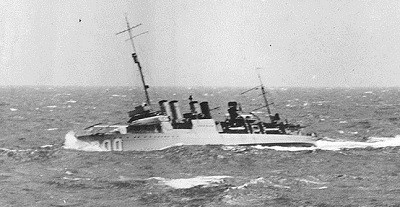
Farragut steamed from Panama on 1 April 1923. The ship suffered engine trouble and required a tow from oiler Neches (AO-5) on 4 April, but she returned to San Diego on 11 April and then resumed DesDiv 31 torpedo practice and gunnery with the Battle Fleet Plane Detachment. The destroyer began a cruise with DesDiv 31 on 29 June, briefly visited San Francisco, arrived at Marshfield, Ore., on 2 July, and reached Seattle, Wash., shortly thereafter. Farragut participated in a Naval Review by President Warren G. Harding, en route home from a tour of Alaska, at Seattle on 27 July.
The ship sailed with a draft of men as part of DesRon 11 and escorted Battle Division 4 on 27 August 1923, and reached San Francisco on 31 August. On the morning of 8 September, 14 destroyers of DesRon 11 put to sea for a two-day voyage to San Diego. The squadron comprised the five ships of Destroyer Division (DesDiv) 33, with Delphy (DD-261) as the van, followed by S.P. Lee (DD-310), Young (DD-312), Woodbury (DD-309), and Nicholas (DD-311); six ships from DesDiv 31, with Farragut, followed by Fuller (DD-297), Percival (DD-298), Somers (DD-301), Chauncey (DD-296), and Kennedy (DD-306); and three ships from DesDiv 32, Paul Hamilton (DD-307), Stoddert (DD-302), and Thompson (DD-305). The warships conducted tactical and gunnery exercises and a competitive speed run of 20 knots. Later in the day the weather worsened, and they formed column on squadron leader Delphy.
Tragically, the flagship broadcast an erroneous report, based on an improperly interpreted radio compass bearing, showing the squadron’s position about nine miles off Point Arguello, Calif., at 2000. An hour later, the destroyers turned east to enter what their navigators believed to be the Santa Barbara Channel, but thick fog obscured the waters that lay ahead of them. An earthquake had devastated the Kantō plain of the central Honshū area of Japan shortly before mid-day on 1 September. The disaster caused abnormally strong currents along the California coast, which, in combination with navigational complacency, led the squadron onto the rocks off Pedernales Point, near Honda, just north of Point Arguello.
Delphy turned but struck the rocks at 2105, plowing ashore at 20 knots. S.P. Lee followed her, striking and swinging broadside against the bluffs. Young piled up adjacent to Delphy and capsized, trapping many of her fire and engine room crewmen below. Woodbury, Nicholas, and Fuller hit reefs and ran aground offshore, and Chauncey ran in close aboard Young. Alarm sirens sounded on board Somers and Farragut as those two ships slowed, just touching ground before backing off in time to avoid the disaster that had befallen their sisters. The other five destroyers steered clear.
The damage from their groundings and the pounding surf eventually wrecked seven destroyers, but the slow, cumulative, process of the ships’ damage gave the crewmen time to escape. Rescue parties scoured the area for sailors, small boats and local fishermen picked up swimmers, and life lines strung to shore allowed the rest to wade to safety. Twenty men, however, died in Young and three in Delphy before the last survivors escaped on the afternoon of 9 September.
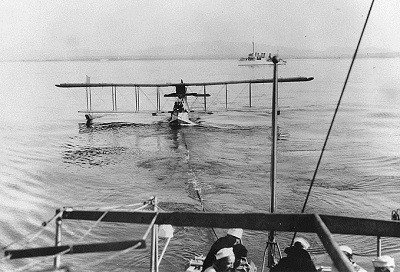
Farragut reached San Diego on 10 September 1923. She completed repairs alongside destroyer tender Melville (AD-2), and on a marine railway at La Playa, that had been designed during World War I to haul medium-sized naval and commercial vessels out of the water for repairs and maintenance. The destroyer then resumed her operating schedule of gunnery training and torpedo recovery.
During the winter the Battle Fleet, Scouting Fleet, and Control Force carried out tactical exercises for Fleet Problems II, III, and IV en route to Panama and from those waters to the point of mobilization at Culebra Island. Farragut helped escort the Battle Fleet from San Diego on 2 January 1924, reaching Balboa on 16 January. The following day, she passed through the Panama Canal to Colón. The destroyer maneuvered with the fleet from Colón to Culebra Island (25 January–1 February), steamed northward and visited Savannah, Ga. (29 February–14 March), and returned to Culebra for scouting maneuvers and advanced battle torpedo practice with the fleet (18–31 March). Farragut put into Colón (31 March–6 April), carried out tactical maneuvers with the other ships, and then passed through the isthmian waterway, Balboa-bound. She returned to San Diego on 22 April.
The ship sailed for fleet tactical exercises off Port Angeles, Wash. (25 June–1 July 1924), after which time she received an overhaul at the Puget Sound Navy Yard (1 September–30 October). She then returned to San Diego, conducting almost daily gunnery practice, as well as torpedo target practice and recovery, with DesRons 11 and 12 during the voyage (30 October–3 November).
Fleet Problem V marked the first problem to incorporate aircraft carriers, though the small size of aircraft carrier Langley (CV-1) and the inexperience of her crew in plane-handling restricted her operations (2–11 March 1925). Farragut steamed as the flagship of DesDiv 31 and the division guide to southern Californian and northern Mexican waters. She screened a Battle Fleet convoy during the exercise, and returned to San Diego on 12 March. The ship took part in scouting line and torpedo firing tactics outside the harbors of San Pedro and Los Angeles, Calif.
Seaplane No. 1, a Vought UO-1 embarked on board Oklahoma, flew an urgent mail run from the battleship to San Diego on 1 April 1925. The plane suffered an engine casualty and made a forced landing about ten miles off Oceanside, Calif., at 1750. Heavy seas and wind buffeted the plane, but the pontoons remained intact. The pilot examined the engine and discovered that cylinder No. 7 had been carried away during the accident, and part of the crankcase around Nos 6 and 8 had fractured. When the plane failed to return to San Pedro, several destroyers including Farragut began to search for it, beginning shortly after 1900. At 0130 on 2 April, destroyer Henshaw (DD-278) spotted the seaplane signaling with its lights, about eight miles off Del Mar. Henshaw secured the plane astern of her until 1130, when tender Aroostook (CM-3), en route from San Diego to San Pedro, stopped and hoisted the aircraft on board.
Farragut put to sea in company with the fleet for an exercise toward Hawaiian waters on 3 April 1925. She paused at San Francisco (5–15 April) and then sailed as part of a convoy screening formation. The destroyer reached Pearl Harbor, Oahu, Territory of Hawaii (T.H.), on 27 April, and received men on board for transfer to Puget Sound Navy Yard. She departed on 7 May, and reached Bremerton on 14 May. The ship completed an overhaul in drydock while many of her crewmen attended the torpedo school at Keyport, Wash. (14 May–14 July). Farragut sailed on 14 July and visited Pearl Harbor on 19 July. She then joined other ships present at Lahaina Roads, off the island of Maui, T.H., for operations that included target practice.
Pilot Cmdr. John Rodgers, copilot Lt. Byron J. Connell, and a crew of three attempted to fly a PN-9 flying boat (BuNo A-6878), from San Francisco to Honolulu on 31 August 1925. Lack of fuel forced the plane down shortly after 1600 on 1 September. Despite an extensive air and sea search, Rodgers and his crew remained lost at sea for ten days, but the intrepid aviators rigged sail from the wing fabric and set course for the island of Kauai. The PN-9 covered about 450 miles under sail before the submarine R-4 (SS-81) sighted the flying boat on 10 September, barely ten miles from the goal of the voyage. The Fédération Aéronautique Internationale accepted the 1,841.12 statute miles they flew until the landing as a new world airline distance record for Class C seaplanes, a record that remained unbeaten for almost five years.
Farragut had steamed from Pearl Harbor on 7 September 1925 as one of ten ships, including Langley and Aroostook, that formed a ‘flight line’ to search for Rodgers and his crew. The plane apparently passed near Farragut’s patrol station, but the sailors involved afterward failed to determine where this occurred, however, because a radio compass bearing from Aroostook, steaming on station before Farragut, placed the plane to the south of the tender, but Rodgers’s dead reckoning placed the PN-9 to the north of her. Farragut returned to San Diego on 17 September. During the remainder of that month and into October, the ship carried out torpedo recovery for Battleship Division 4 off San Pedro, and torpedo firing practice with DesDiv 31.
Halfway into the forenoon watch on 27 January 1926, during long-range battle practice and battle torpedo practice “B” off Point Loma, Calif., Farragut was engaged in making a run, firing 4-inch salvoes to port, when a cartridge exploded in gun no.2, blowing the base of the cartridge case and the breech-plug assembly out the rear, the plug itself passing through the gravity tank, no. 1 stack, and part of the bridge. Fragments holed no.1 stack, holed and dished-in a portion of the no.2 stack, badly damaged the ammunition rack for no.2 gun, damaged the life raft alongside no.1 stack, the blast carried away the rail on the starboard bridge ladder, dished-in (but did not perforate) the forward well-deck bulkhead, and tore up wiring and voice tubing in the wake of the explosion. In addition, the concussion tore away the girder supporting the after end of the bridge and decking just outboard of the starboard bridge ladder.
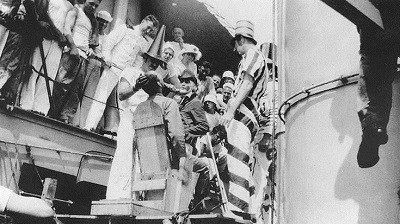
Despite the fact that the presence of a board convened in the destroyer tender Melville resulted in the division medical officer not being present at the time of the accident, prompt action to obtain medical attention to the injured men ensued. Chief Pharmacist’s Mate Albert E. Stanley, although suffering a laceration of his left leg, “tendered efficient first aid to the injured…” Seaman 2nd Class Otis L. Bogar died of severe burns and multiple injuries that day, however, while Chief Boatswain’s Mate Joseph Becker, “an experienced gun captain…efficient and careful in the performance of his duties…” succumbed to burns, multiple wounds, and shock at the U.S. Naval Hospital, San Diego, Calif., twenty minutes into the mid watch on 28 January 1926.
Other men who suffered injuries of varying severity that morning included Seaman 1st Class Joseph G. Lea, Seamen 2nd Class Allen A. Bursley, John M. Carter, and Ernest C. Lively, Coxswain Ernest A. McKinnon and Mess Attendant 2nd Class Mauricio B. Magante. Fireman 2nd Class Floyd A. English, knocked down by the force of the blast, protected the base of a loaded cartridge with his hand.
The ensuing court of inquiry opined that Farragut carried out the battle practice properly, with her gun crews well versed in safety precautions. It found that “on the round previous to the explosion the firing-pin point was broken off and pressed to one side of the orifice of the face of the plug, where it remained lodged securely, either wedged or brazed by metal from the primer,” and that the broken-off portion of the firing pin “struck the cap of the primer when the plug was being closed, causing the cartridge to explode before the plug was locked.” In failing to detect the condition, the court of inquiry believed, the gun captain, who died of his injuries suffered in the explosion, had unwittingly and indirectly caused the accident. The Farragut’s men had been “well drilled, instructed, and disciplined” before, during, and after the accident, rising to the occasion to “care for the injured and to safeguard material.”
The court concluded “that the deaths and injuries…were incurred in the line of duty and were not due to the misconduct or to the fault, inefficiency, or negligence of any person or persons in the naval service or connected therewith.” The court recommended no further proceedings and that the parts recovered (practically the entire breech mechanism, part of the cartridge that had exploded, and the “eight other cartridge cases said to have been fired from gun no.2 on [that] run”) be forwarded to the Bureau of Ordnance “for such further examination as the bureau may desire to make.”
While Rear Adm. Frank H. Schofield, Commander Destroyers, Battle Fleet, approved the court’s proceedings, findings, opinion, and recommendations, Adm. Charles F. Hughes, Commander in Chief, Battle Fleet, found that “regrettably…the explosion which resulted in the deaths and injuries…was due to the failure of the gun captain to comply fully with the safety regulations.” The Chief of Naval Operations concurred in the opinions of the reviewing authority, while the Chief of the Bureau of Ordnance concluded by noting the gun captain’s failure, he also directed the attention of all concerned to the necessity of “completely assembling the firing mechanism in the breechblock in the proper manner…”
Soon thereafter, regular operations resumed, with Farragut sailing in company with the Battle Fleet from San Diego on 1 February 1926 to take part in Fleet Problem VI, a joint Army-Navy minor problem that involved strategic and tactical exercises in the vicinity of the Panama Canal Zone eastward toward Puerto Rico. Farragut reached Balboa on 15 February, and maneuvered at sea with the fleet off Culebra Island (15–20 March). She returned to San Diego on 1 April.
The ship steamed for a cruise up the west coast on 14 June 1926. Cmdr. Roscoe C. MacFall broke his flag in Farragut in command of DesDiv 31, DesRon 11. Farragut rendezvoused with the Battle Fleet, and reached Bremerton on 20 June. She took part in additional maneuvers with the Battle Fleet and returned to San Diego (2 August–1 September).
Farragut departed San Diego to participate in Fleet Problem VII on 27 February 1927. The problem called for the Blue Fleet, which comprised the Battle Fleet less submarine divisions, Train Squadron 2, and submarines operating from Coco Solo, to escort a large and slow overseas convoy, and then to establish a base. The Black Fleet, which consisted of the Scouting Fleet, Train Squadron 1, and the Control Force less the submarines at Coco Solo, opposed these operations. Farragut reached Balboa on 3 March, and passed through the Panama Canal and lay-to at Colón (4–9 March).
The Black Fleet blockaded the various passages into the Caribbean from its principal base at Gonaives, Haiti, where Farragut joined the fleet on 14 March 1928. Following the problem, the ship took part in the Annual Military Inspection at Guantanamo Bay, Cuba (18–26 March). Farragut then continued northward with a fleet cruise along the east coast, and visited New York (29 April–16 May) and Newport, R.I. (20–28 May). She took part in joint Army-Navy maneuvers off Hampton Roads, Va. (29 May–4 June). The ship passed through the Panama Canal on 11 June and returned to San Diego on 25 June. Farragut assisted DesDivs 30 and 32 with various torpedo and depth charge training and night battle practice through the summer.
Farragut took part in Fleet Problem VIII in Pacific waters between San Francisco and the Hawaiian Islands (18–28 April 1928). Fleet Problem VIII provided limited experience in aircraft carrier operations and in scouting patrols. Langley took part, with a lengthened flight deck and altered arresting gear, and in combination with her crew’s improved expertise in aircraft handling operated 42 planes: 30 fighter and 12 observation types. Aircraft tenders Aroostook and Gannet (AM-41) also took part, but the Bureau of Aeronautics reported that “little could be expected from a problem in which air operations were so limited and where the air forces available were so small.” Farragut sailed from San Diego on 9 April, operated with the other ships of the fleet off San Francisco and toward Hawaiian waters (10–18 April), and visited Pearl Harbor upon the conclusion of the exercise on 28 April. The destroyer sailed from Pearl on 15 June, and returned to San Diego on 23 June.
The ship put to sea on 1 July 1928, visited Newport, Ore. (2–7 July) and Tacoma, Wash. (8–16 July), and completed her annual overhaul at Puget Sound (16 July–25 August). She sailed on 25 August and rejoined the Battle Fleet at San Francisco (28–31 August). Farragut visited the Pacific Southwest Exposition at Long Beach, Calif. (1–4 September).
Farragut steamed from San Diego on 15 January 1929 to take part in Fleet Problem IX (23–27 January). The participation of aircraft carriers Lexington (CV-2) and Saratoga (CV-3), attached to the opposing forces, introduced new elements into fleet operations, including Saratoga’semployment to achieve the theoretical destruction of the Panama Canal. The Black fleet, including Saratoga and Aroostook (that relieved Langley while she completed yard work), represented a ‘Pacific power’ and steamed toward the Panamanian Isthmus to attack the Blue fleet, including Lexington, which portrayed the U.S. fleet as it passed through the Panama Canal. Subject to that condition, planners intended the Black fleet to attempt to attain surprise.
Saratoga and light cruiser Omaha (CL-4) detached from the Blue force on 22 January 1929, and sailed on a wide southward sweep before turning north to approach the canal. Saratoga launched a strike group of 69 planes that arrived over the Miraflores and Pedro Miguel Locks undetected shortly after dawn on 26 January, and “destroyed” the locks without opposition. The following morning, Lexington sighted Saratoga on her port quarter at 17,000 yards and opened fire with her 8-inch guns.
The Bureau of Aeronautics noted that the losses incurred drove home the necessity of providing carriers with the “maximum escort protection.” The demonstration impressed naval leaders, and in the 1930 maneuvers a tactical command built around an aircraft carrier appeared in the force organization. Observers also noted the concentration of naval air power in a handful of ships that confirmed the need for small carriers to supplement the larger fleet types. Farragut sailed from Panama Bay on 11 March and returned to San Diego on 22 March.
The destroyer put to sea for the Pacific Northwest on 18 June 1929, stopped at Newport to celebrate Independence Day (29 June–5 July), then rejoined her division off Port Angeles (6–18 July). Farragut visited Portland to participate in the dedication of a bronze tablet memorial for Lt. William R. Broughton, RN, at Crown Point, Ore. (22 August). Broughton, a member of the Capt. George Vancouver [RN] Discovery Expedition, spotted Mount Hood on 29 October 1792, and the following day named it for Vice Adm. Samuel Hood, RN. She then took part in Army and Navy maneuvers off Port Townsend, Tacoma, and Port Angeles, Wash. (19–25 September).
Farragut was decommissioned at San Diego on 1 April 1930, and stricken on 22 July 1930. The ship was scrapped, and on 31 October 1930 her materials were sold in accordance with the Treaty for the Limitation and Reduction of Naval Armament (popularly known as the London Naval Treaty).
Mark L. Evans
10 June 2013
